Qaqrat Monster Washes Ashore in Alaska
Posted by: Loren Coleman on August 8th, 2008
Qaqrat is a word in the Inuit dialect of Cup’ig, Nunivak Island’s native language. It is phonetically pronounced “koo-gat” and translates as “beast-walrus.” One could say that the carcass of a qaqrat has graced itself upon Alaska. Will the fabled “beast-walrus” be the next media darling?
After all the news attention to the recent carcass, the Montauk Monster, that washed ashore at a beach in New York, you might expect to hear about more such incidents this summer.
A little paper in Seward, Alaska, seems to be the first one to tell of an actual similar unknown. Unfortunately, they have published their story without the benefit of the photograph they discuss. Therefore, I’ve included here some examples of carcasses that have turned up in Alaska recently, for illustrative and commentary purposes, until the actual photo of the new Alaskan remains surfaces.
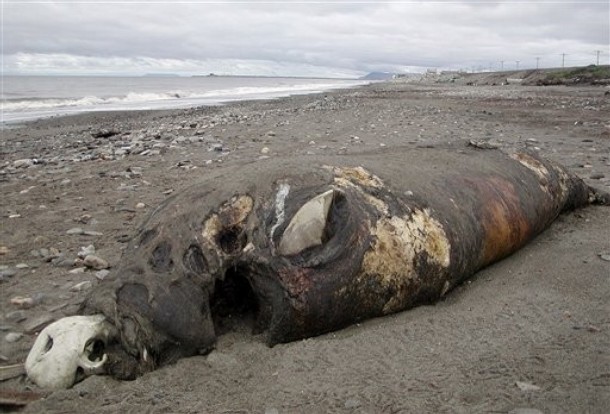
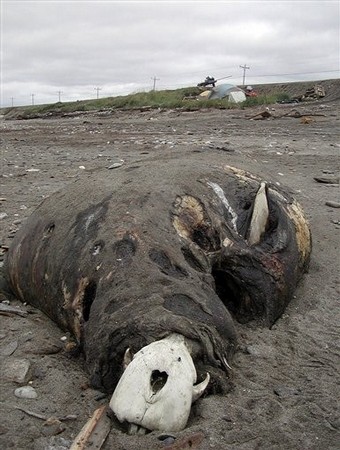
Walrus carcasses began coming ashore near Nome, Alaska, a year ago. Here is a couple photographs by Diana Haecker, taken on August 15, 2007.
A beluga carcass on a beach in Alaska, also from August 2007.
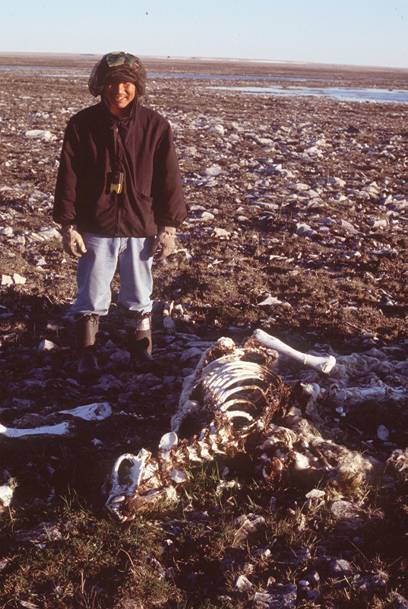
A polar carcass on Southampton Island, Summer 2003.
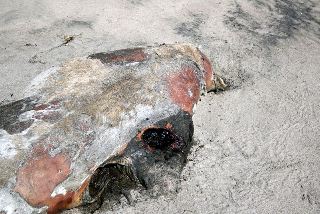
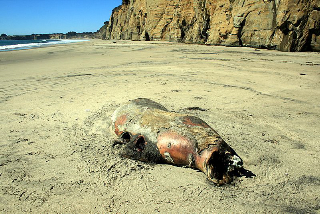
Two images, from different angles, of a beached elephant seal.

Beached whales are a common enough event in Alaska, too.
Here’s the details on this new case (if you discover the photo, let Cryptomundo know):
Residents from a Western Alaska island are turning to Cup’ig lore and the expertise of scientists to identify the strange remains of an animal coughed up by the Bering Sea.
At least one resident of Mekoryuk – Nunivak Island’s only village – thinks the smooth-skinned corpse might be the lake-dwelling beast rumored about in local legend.
An e-mailed photo of the animal – sporting what appears to be a tail – has reached several computers, including one belonging Mike Castellini, director of the Coastal Marine Institute at the University of Alaska Fairbanks.
It’s impossible to identify the animal from the photo, but several scientists have tried, Castellini said.
“It’s been sent to stranding experts and scientists as far as the Smithsonian and everyone is going, ‘No idea,’ ” Castellini said.
It could be a mangled beluga whale, the identifying parts obscured in the photo, he said.
A team of UAF scientists who happen to be on the island studying subsistence foods are trying to line up a boat ride to the remote site to see the creature for themselves, Castellini said.
It’s not a whale, said Barry Whitman, who e-mailed the photo to Castellini.
Whitman and his wife, Lisa, spotted the pinkish hunk of flesh while returning to the village of about 200 from a salmon fishing trip on the island’s east side on Tuesday, July 22.
From far way, the bulky body looked walrus-like.
Thinking it might have valuable tusks they could salvage, the couple motored in for a closer look, scaring off scavenging sea gulls. Barry pulled the skiff within a few feet of the thing but didn’t slide ashore for fear of banging the boat against rocks.
Lisa stood in the bow snapping several photos showing the animal from a single angle.
Whitman, 30, grew up hunting and fishing near the village of 200.
“I’ve seen decomposed walrus and whales and this was just something else,” he said.
A thick coat of hair seemed to cover the underside. Barry couldn’t figure out the head from the tail.
Lisa had the best view. She said the 3-foot long tail – or what she thinks was the [tail] – seemed to end in a diamond shape. The animal’s body was about 6 feet long, she said. The head may have been removed or hidden in sand, she said.
“I was pretty baffled,” said Lisa, an optometry technician at Bethel’s regional hospital.
The couple spent only a few minutes at the carcass because they had to catch their fishing partner. Moses Whitman Sr., Barry’s dad, was heading back to Mekoryuk in a larger boat that couldn’t come close to shore.
The couple had hoped to return to the site later but the weather was too windy in the short time Barry had in Mekoryuk – he needed to get back to Bethel where he’s a pilot.
Moses said he’s never seen any animal like the one in the photo.
The photo reminds him of an old Cup’ig story about an animal that lived in a pond.
Around the early 1960s, he remembers seeing evidence of large creatures that had traveled between a pond on Nunivak Island and the Bering Sea.
“Seemed like somebody bulldozed a path out to the ocean and there was three of them,” he said.
That animal was called qaqrat in Cup’ig, the island’s Native language, said Howard Amos, who helped author the Cup’ig dictionary and administers the village’s elementary’s Cup’ig program.
Phonetically, that’s pronounced “koo-gat.” It means “beast-walrus,” Amos said.
According to legend, when the beast-walrus left the lake and moved to the ocean, the lake dried up, Amos said. The animal was walrus-like and wasn’t aggressive to humans.
Whatever the animal is, Whitman would love to find out.
“I always believed there was something more out there than whales and walruses and what we know is out there because the ocean is huge,” he said.
Source: “Beached carcass may be thing of legends,” by Alex DeMarban, Seward Phoenix Log, August 07, 2008 at 11:13AM AKST.
About Loren Coleman
Loren Coleman is one of the world’s leading cryptozoologists, some say “the” leading living cryptozoologist. Certainly, he is acknowledged as the current living American researcher and writer who has most popularized cryptozoology in the late 20th and early 21st centuries.
Starting his fieldwork and investigations in 1960, after traveling and trekking extensively in pursuit of cryptozoological mysteries, Coleman began writing to share his experiences in 1969. An honorary member of Ivan T. Sanderson’s Society for the Investigation of the Unexplained in the 1970s, Coleman has been bestowed with similar honorary memberships of the North Idaho College Cryptozoology Club in 1983, and in subsequent years, that of the British Columbia Scientific Cryptozoology Club, CryptoSafari International, and other international organizations. He was also a Life Member and Benefactor of the International Society of Cryptozoology (now-defunct).
Loren Coleman’s daily blog, as a member of the Cryptomundo Team, served as an ongoing avenue of communication for the ever-growing body of cryptozoo news from 2005 through 2013. He returned as an infrequent contributor beginning Halloween week of 2015.
Coleman is the founder in 2003, and current director of the International Cryptozoology Museum in Portland, Maine.










I think the ocean is really (one of) the best palce(s) to find wild and ‘unreal’ new creatures as so little of the ocean (in the grand scheme of things) has been explored. We all remember Giant Squid right? and ‘the bloop?’ 😉
Here’s hoping Steller’s sea cow has been rediscovered!
Hard to say anything really until we can actually get a look at the thing ourselves. I will say that the ocean has a long history of coughing up strange things and a lot of the time (but not always), these things turn out to be perfectly mundane phenomena. Carcasses are also notorious for looking very anomalous and unlike the original animal due to decomposition, the effect of scavengers, and so on. There have been cases where so called “experts” say that it couldn’t possibly be so and so, and then it turns out to be exactly that. Look at globsters for good examples of this. Anyway, no way to make a call from the report alone. I’d say let’s keep our heads straight until we see the photographic evidence. I too would like to find out what it is in a critical, rational manner.
It’s the bloated carcass of the postcard cryptid fish.
Giant Alaskan plattypus?
Could be that Qaqrat critter I suppose, but did they see any indicative tusks? As it’s been said, this really could be anything. Could the “hair” even be mold?
Gavin, that was my first thought, too, those these are far too small for adult stellar’s sea cattle.
I say we name it the Bering Beast 🙂 it has that catchiness that the media loves
“Bering Beast” won’t work because it has the confusing sound of a nude Nunivak nasty, and the tv & radio reporters just can’t have that.
With the nearest and only village being Mekoryuk, I can see the media calling it the “Mekoryuk Monster” to go right along with the “Montauk Monster”. Something for the name game and similarity files, maybe.
Menace of Mekoryuk? Whitman’s Wonder? Nunivak Nemesis? Who knows what people will call it when the photos finally surface…
Or maybe for now we should just call it old Kooky (for Qaqrat)
I hadn’t even thought of that Loren, and I can understand trying to tie it into all of the hype from the Montauk Monster but it’s not every day that we have cryptid carcasses washing ashore with the news making it to us, you got to have some fun with it 🙂
Any news on the supposed photos?
Thats an interesting article!..My brother (James Whitman) lives on that island,We havent talked in a while,but I do have a link to an artist from the island…maybe I can get something from him…I’ll try.
It will always be “Kooky” to me, now. Done and done.
Carcesses are intresting when they are unidentified.cryptids are very Intresting.